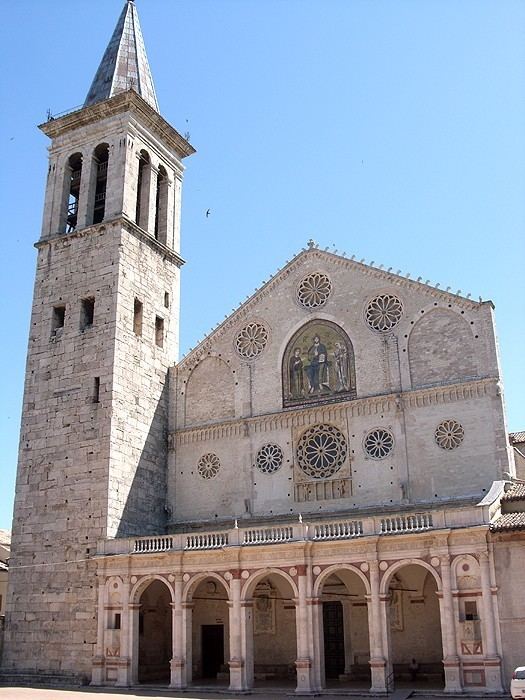Parishes 76 Area 1,836 km² | Established 1st century Phone +39 0743 231020 | |
 | ||
Population- Total- Catholics (as of 2010)104,215101,750 (97.6%) Similar Museo Diocesiano, Cathedral, Parrocchia S Matteo Apostolo, Santuario Madonna Della Stella, bed and breakfast San Ponz | ||
The Italian Catholic Archdiocese of Spoleto-Norcia (Latin: Archidioecesis Spoletana-Nursina), historically the Diocese of Spoleto, and an archdiocese since 1821, is directly subject to the Holy See.
Contents
History
Spoleto, the Roman Spoletium, surrendered in the Gothic war (537) to the Byzantine general, Constantine; but in 546 it was recovered by Totila, and it was not retaken by the Byzantines until 552, when Narses restored the fortifications. In 572 Spoleto became the seat of a Lombard duke, Faroald.
Under Hildebrand, the Duchy of Spoleto was promised to the Holy See by the King of the Franks, and the duke himself was named by Pope Adrian (773), but the succeeding dukes were named by the Frankish emperors. Winigisus aided Pope Leo III against his enemies.
Duke Lambert distinguished himself in the wars against the Saracens, but disgraced himself by massacres at Rome in 867; he was afterwards deposed (871), then restored (876), but was a second time excommunicated by Pope John VIII. In 883 Guido II of Spoleto united under his sway the entire dukedom, which from this time was called the Duchy of Spoleto and Camerino. After the death of Charles the Fat (888), Guido had himself crowned Roman Emperor and King of Italy under Pope Stephen V (891); Pope Formosus in 892 also crowned his son Lambert II, who succeeded his father in the dukedom, kingdom, and empire.
Alberico I, Duke of Camerino (897), and afterwards of Spoleto, married the notorious Marozia; he was killed by the Romans in 924. His son Alberico II made himself also master of Rome and remained there until the election to the papacy of his son John XII.
During the conflict between the papacy and the Emperor Henry IV, the latter named other dukes of Spoleto. After this the dukedom was in the family of the Werners (Guarnieri) of Urslingen, Margraves of Ancona.
The popes maintained at Spoleto a governor, who was often a cardinal. As early as the thirteenth century, and more frequently in the fourteenth, Spoleto was involved in wars with Perugia, Terni, and other cities; in 1324 it was almost destroyed by the Perugians. In 1319 the struggle between the Guelphs and Ghibellines tore the city. Cardinal Albornoz favoured the city for the services which it rendered in the restoration of the papal power, and made it independent of Perugia.
At the beginning of the Western Schism, Pietro di Prato succeeded in occupying Spoleto for the antipope Clement VII, but was expelled by Pope Boniface IX. King Ladislaus of Naples, in 1414 endeavoured in vain to make himself master of the city. Pope Eugenius IV named as governor the Abbot of Monte Cassino, Piero Tomacelli, who was tyrannical to such an extent that the people besieged him in his castle, and in 1438 summoned the bands of Piccinino to free them. In 1480 Cardinal Vitelleschi ended the tyranny of Piero and of the Trinci of Foligno.
Spoleto venerates as its apostle St. Brictius, who is also venerated in other cities of Umbria and Tuscany. The legend of his life is so full of anachronisms. The names of other martyrs are also recorded at Spoleto, like St. Gregory the Priest; the name Ponte Sanguinario is said to record a great massacre of Christians.
Another martyred bishop was St. Saturnius (270), and during the persecution of Diocletian the martyrdom of St. Savinus, Bishop of Assisi, took place at Spoleto. The first bishop of certain date is Cæcilianus, to whom Pope Liberius wrote a letter in 354. There is record of
At the time of Bishop Petrus (573) Spoleto was under Arian rule. It is told that an Arian bishop in Spoleto wished to enter the Church of San Pietro, then the cathedral, by force, but was stricken with blindness. To Bishop Chrysanthus (591) St. Gregory the Great wrote four letters, in one of which he admonished him not to discipline fugitive monks so lightly. Other bishops were:
After he had destroyed the city, Frederick Barbarossa presented to the cathedral the so-called Madonna of St. Luke, a Byantine work with inscriptions of a dialogue between Mary and Jesus. Nicolò Porta, who became bishop in 1228, was transferred in 1236 to the Patriarchate of Constantinople.
Niccolò da Prato (+1321) who had served as lector at the studium at Santa Maria sopra Minerva forerunner of the Pontifical University of Saint Thomas Aquinas, Angelicum, was made Bishop of Spoleto (1299-1303) by Pope Boniface VIII.
Bartolommeo de Bardi, O.Min. (1320), was Governor of Terni.
In 1417, on the death of Bishop Jacopo, who was a partisan of Pope John XXIII, the clergy wished to proceed to the election of a new pastor but the people prevented them, proclaiming as bishop Nicolò Vivari, the nominee of Pope Gregory XII.
Again in 1433 the clergy wished to revive their right of electing a bishop, but the intervention of Eugenius IV prevented them. Other bishops were:
After the death of Cardinal Locatelli (1812), Napoleon nominated Bishop Antonio de Longo, whom the canons were unwilling to obey, and were therefore nearly all exiled.
In 1820 Spoleto became a metropolitan see and the ancient Diocese of Norcia was taken from its territory. Giovanni Maria Cardinal Mastai-Ferretti (1827–32), afterwards Pope Pius IX, was Archbishop; in 1837 he persuaded four thousand rebels to lay down their arms.
Diocese of Spoleto
Latin Name: Spoletanus
Erected: 1st Century
...
...
...
Archdiocese of Spoleto
Elevated: 15 January 1821
Latin Name: Spoletanus
Immediately Subject to the Holy See
